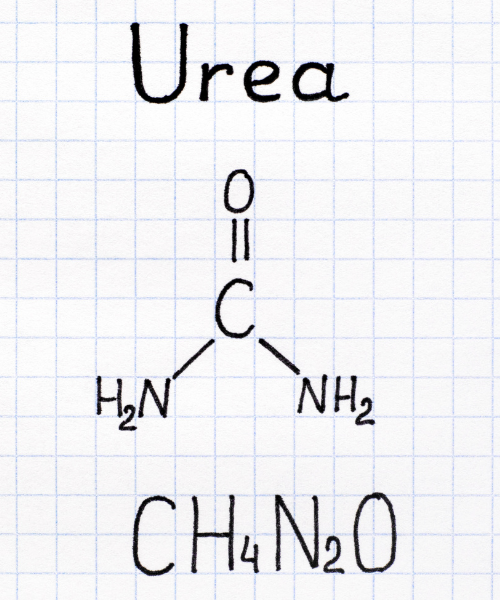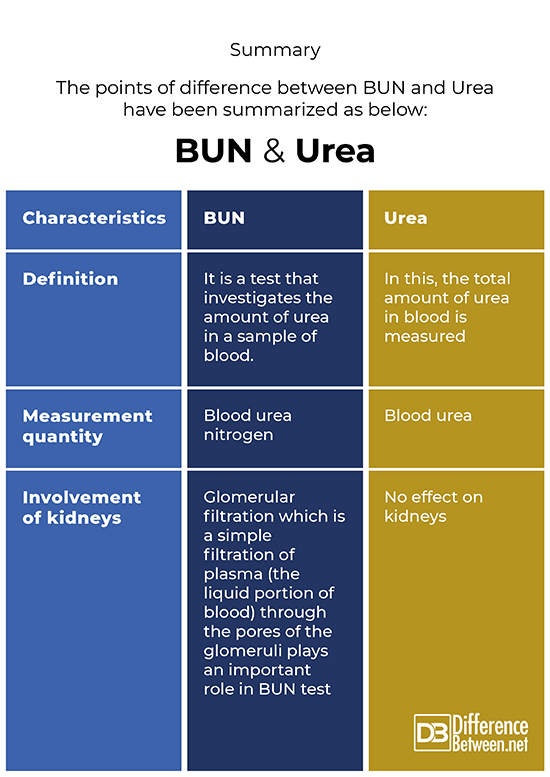Difference Between BUN and Urea
What is BUN and Urea?
These are medical tests which are a part of normal and regular health (specifically kidneys) screening procedures. BUN is the blood urea nitrogen test that measures the volume of urea nitrogen found in blood and blood urea investigates the total concentration of urea found in blood following its production from the urea cycle in the liver. The main difference between the two depends on the type of component measured in each parameter.
Similarity
- Both BUN and Urea are measured in milligrams per deciliter (mg/dL).
- Both are similar in their biological role and the action mechanism.
- Both are indicative of protein metabolism

BUN
Also termed as serum BUN test, it is a blood urea nitrogen test that investigates and assesses the amount of waste (urea nitrogen) present in your blood. The test helps to determine how well your kidneys are working. It is used for diagnosis (symptoms of kidney disease like frequent episodes of fatigue), screening (detect a health issue before symptoms have shown up), and monitoring (how a patient’s condition changes) of any issues with the kidneys.
If the BUN test shows that BUN levels are too high, then it is an indication of kidneys not functioning properly. High blood urea nitrogen levels can also be triggered by low blood flow to the kidneys. Low blood flow to the kidneys is caused either by heart failure or dehydration.

Urea
Blood urea is the concentration of urea present in the blood. Urea is actually waste that gets created in the liver and excretes from the body in the form of urine. If for some reason, kidneys do not function properly and are unable to get rid of waste in the form of urea from the blood naturally, the BUN levels increase. Some other complication that could also cause high BUN levels include – dehydration, high protein diet,
A BUN test is done to see how well your kidneys are working.
Some tips to lower urea levels include:
- Avoid smoking and alcohol
- Eat more fiber
- Lower your salt intake
- Bring down your protein intake
- Avoid over using NSAIDs
Difference between BUN and Urea
Definition
BUN
In BUN test, the content of nitrogen in urea is measured. The normal BUN level is between about 7 and 21 mg/dL
Urea
In blood urea, the amount of urea present in blood is measured.
Symptoms
BUN
Symptoms of abnormal BUN include:
Increased BUN symptoms include:
- Oliguria or anuria
- Dehydration
- Urge to urinate frequently or infrequently
- Disturbed sleep or sleep disorder
- Pale skin color
- Swelling in your arms, legs, or feet
- Edema or anasarca
- Uremic frost
- Itching
- Tachycardia
- Fatigue that is recurring
- Confusion
- Muscle cramps
- Muscle cramps
- Vomiting
Decreased BUN symptoms include:
- Jaundice
- Wasting syndrome
Urea
Symptoms of high urea (uraemia) include:
- Altered taste
- Extreme tiredness or fatigue
- Nausea
- Extreme sleepiness
- Cramping in your legs
- Vomiting
- Little or no appetite
- Cognitive dysfunction (problems with thinking and remembering)
- Unexplained weight loss
- Trouble concentrating
- Shortness of breath from fluid accumulation
- Headache
Kidney involvement
BUN
Kidneys are involved as the BUN test indicates kidney dysfunction or injury
Urea
Kidneys are not involved in this case.
Summary
The points of difference between BUN and Urea have been summarized as below:

FAQ
How does BUN relate to urea?
Urea is made when a metabolite (breakdown product) of amino acid is broken down in your body. It is created in the liver and excreted out of your body in the urine. A Blood Urea Nitrogen test is carried out to determine the performance of your kidneys and to identify any potential risks, diseased or damaged kidneys. If your kidneys are unable to eliminate urea from the blood in a normal manner, the blood urea nitrogen in your body will increase.
Does high BUN mean uremia?
No, high BUN may not necessarily mean that the patient has uremia.
What is the difference between BUN and creatinine?
BUN is termed as Blood Urea Nitrogen used by nephrologists or kidney specialists to check the hydration status and to assess kidney function whereas creatinine is the breakdown product of creatine phosphate or waste product from muscle and protein metabolism which is secreted at the glomerulus (a cluster of small blood capillaries known as a tuft around the end of a kidney tubule) and not absorbed back or again secreted by the renal tubule. Thus, it gives the correct measure of kidney function.
What causes a high BUN?
A high Blood Urea Nitrogen is caused by a rich protein diet, Addison’s disease (also called adrenal insufficiency), or tissue damage (such as from severe burns), inflammation or interval training, thyroid abnormalities, Glucocorticoids, Tetracyclines, kidney disease or failure and dehydration or low water consumption.
What lab test is BUN?
It is a common blood test; test reveals about the functioning of kidneys. It assesses and measures the urea nitrogen present in the blood.
- Difference Between Global Warming and Greenhouse Effect - May 18, 2024
- Difference Between Vaccination and Immunization - March 3, 2024
- Difference Between Selective Mutism and Autism - February 25, 2024
Search DifferenceBetween.net :
Leave a Response
References :
[0]Arihan, O., Wernly, B., Lichtenauer, M., Franz, M., Kabisch, B., Muessig, J., ... & Jung, C. (2018). Blood Urea Nitrogen (BUN) is independently associated with mortality in critically ill patients admitted to ICU. PloS one, 13(1), e0191697.
[1]Gutmann, I., & Bergmeyer, H. U. (1974). Urea. In Methods of enzymatic analysis (pp. 1791-1801). Academic Press.
[2]Salazar, J. H. (2014). Overview of urea and creatinine. Laboratory medicine, 45(1), e19-e20.
[3]Xie, Y., Bowe, B., Li, T., Xian, H., Yan, Y., & Al-Aly, Z. (2018). Higher blood urea nitrogen is associated with increased risk of incident diabetes mellitus. Kidney international, 93(3), 741-752.
[4]Image credit: https://www.canva.com/photos/MAC5lRoEF7k-chemical-formula-of-urea-/
[5]Image credit: https://www.canva.com/photos/MAC7aIKrZyo-blood-chemistry-report-showing-normal-urea-and-electrolyte-levels-sodium-potassium-chloride-carbon-dioxide-urea-creatinin/
